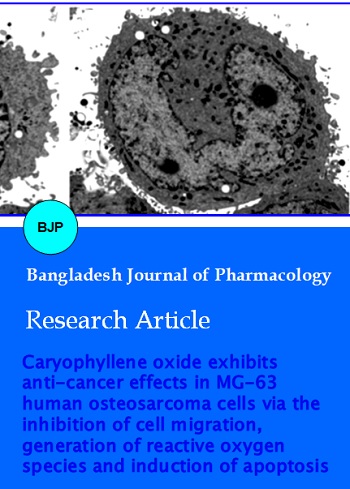Caryophyllene oxide exhibits anti-cancer effects in MG-63 human osteosarcoma cells via the inhibition of cell migration, generation of reactive oxygen species and induction of apoptosis
DOI:
https://doi.org/10.3329/bjp.v11i4.27517Keywords:
Apoptosis, Cancer, Caryophyllene oxide, Cell migration, MG-63 human osteosarcoma cell, Reactive oxygen speciesAbstract
The main objective of the present study was to evaluate the antitumor and apoptotic effects of caryophyllene oxide in MG-63 human osteosarcoma cells. Cell viability of these cells was evaluated by MTT assay while as in vitro wound healing assay was used to study the effect of caryophyllene oxide on cell migration. Fluorescence microscopy and transmission electron microscopy were used to study the changes in cell morphology once the cells undergo apoptosis. Caryophyllene oxide significantly led to cytotoxicity in MG-63 cells showing dose-dependent as well as time-dependent effects. Caryophyllene oxide led to an inhibition of wound closure significantly. At caryophyllene oxide doses of 20, 80 and 120 µM, the percentage of cell migration was shown to be 94.2, 67.1 and 14.8% respectively. With an increase in the caryophyllene oxide dose, the extent of apoptosis also increased characterized by cellular shrinkage, membrane blebbing, chromatin condensation and apoptotic body formation.
Video Clip of Methodology:
Cell viability assay: 2 min 22 sec Full Screen Alternative
Downloads
1726
877 Read
892

Published
How to Cite
Issue
Section
License
Authors who publish with this journal agree to the following terms:
- Authors retain copyright and grant the journal right of first publication with the work simultaneously licensed under a Creative Commons Attribution License that allows others to share the work with an acknowledgement of the work's authorship and initial publication in this journal.
- Authors are able to enter into separate, additional contractual arrangements for the non-exclusive distribution of the journal's published version of the work (e.g., post it to an institutional repository or publish it in a book), with an acknowledgement of its initial publication in this journal.
- Authors are permitted and encouraged to post their work online (e.g., in institutional repositories or on their website) prior to and during the submission process, as it can lead to productive exchanges, as well as earlier and greater citation of published work (See The Effect of Open Access).
